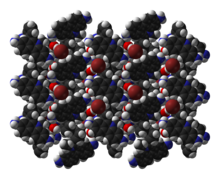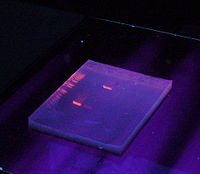Ethidium bromide

| |

| |

| |
| Names | |
|---|---|
| Preferred IUPAC name
3,8-Diamino-5-ethyl-6-phenylphenanthridin-5-ium bromide | |
Other names
| |
| Identifiers | |
3D model (
JSmol ) |
|
| 3642536 | |
| ChEBI | |
| ChEMBL | |
| ChemSpider | |
ECHA InfoCard
|
100.013.622 |
| EC Number |
|
| KEGG | |
PubChem CID
|
|
RTECS number
|
|
| UNII | |
| UN number | 2811 |
CompTox Dashboard (EPA)
|
|
| |
| |
| Properties | |
| C21H20BrN3 | |
| Molar mass | 394.294 g/mol |
| Appearance | Purple-red solid |
| Melting point | 260 to 262 °C (500 to 504 °F; 533 to 535 K) |
| ~40 g/l | |
| Pharmacology | |
QP51DX03 (WHO )
| |
| Hazards[1] | |
| GHS labelling: | |
 
| |
| Danger | |
| H302, H330, H341 | |
| P201, P202, P260, P284, P301+P312, P304+P340+P310 | |
| NFPA 704 (fire diamond) | |
| Flash point | > 100 °C (212 °F; 373 K) |
Except where otherwise noted, data are given for materials in their standard state (at 25 °C [77 °F], 100 kPa).
| |
Ethidium bromide (or homidium bromide,
Structure, chemistry, and fluorescence

As with most
Ethidium bromide's intense fluorescence after binding with DNA is probably not due to rigid stabilization of the
Applications

Ethidium bromide is commonly used to detect
Ethidium bromide is also used during DNA fragment separation by agarose gel electrophoresis.[10] It is added to running buffer and binds by intercalating between DNA base pairs. When the agarose gel is illuminated using UV light, DNA bands become visible. Intercalation of EtBr can alter properties of the DNA molecule, such as charge, weight, conformation, and flexibility. Since the mobilities of DNA molecules through the agarose gel are measured relative to a molecular weight standard, the effects of EtBr can be critical to determining the sizes of molecules.[11]
Ethidium bromide has also been used extensively to reduce mitochondrial DNA copy number in proliferating cells.[12] The effect of EtBr on mitochondrial DNA is used in veterinary medicine to treat trypanosomiasis in cattle, as EtBr binds molecules of kinetoplastid DNA and changes their conformation to the Z-DNA form. This form inhibits replication of kinetoplastid DNA, which is lethal for trypanosomes.[13]
The chloride salt homidium chloride has the same applications.[3][4]
Ethidium bromide can be added to YPD media and used as an inhibitor for cell growth.[14]
The binding affinity of the cationic nanoparticles with DNA could be evaluated by competitive binding with ethidium bromide.[15][16]
Alternatives for gel
There are alternatives to ethidium bromide which are advertised as being less dangerous and having better performance.
Possible carcinogenic activity

Most use of ethidium bromide in the laboratory (0.25–1 µg/ml) is below the LD50 dosage, making acute toxicity unlikely. Testing in humans and longer studies in a mammalian system would be required to fully understand the long-term risk ethidium bromide poses to lab workers, but it is clear that ethidium bromide can cause mutations in mammalian and bacterial cells.[22]
Handling and disposal
Ethidium bromide is not regulated as hazardous waste at low concentrations,
The disposal of laboratory ethidium bromide remains a controversial subject.
Drug resistance
Trypanosomes in the Gibe River Valley in southwest Ethiopia showed universal resistance between July 1989 and February 1993.[29] This likely indicates a permanent loss of function in this area against the tested target, T. congolense isolated from Boran cattle.[29]
See also
- Phenanthridine
- Agarose gel electrophoresis and gel electrophoresis of nucleic acids
- GelRed (itself derived from ethbr) and GelGreen, marketed as safer and more intense DNA stains
- Propidium iodide and propidium monoazide, related dyes
References
- ^ "GESTIS-Stoffdatenbank". gestis.dguv.de (in German). Retrieved 22 November 2021.
- ^ "Homidium bromide". PubChem. NCBI, NLM, US NIH. Retrieved 2020-09-08. CID 14710 from PubChem
- ^ S2CID 27564786.
- ^ a b "Homidium chloride". PubChem. NCBI, NLM, US NIH. Retrieved 2021-03-14. CID 11765 from PubChem
- PMID 7676909.
- ^ a b Lowe, Derek (2016-04-18). "The Myth of Ethidium Bromide". In the Pipeline. Retrieved 2019-02-28.
- ^ "Ethidium Bromide: Swap or Not | UCSB Sustainability". sustainability.ucsb.edu. Retrieved 2023-02-08.
- ISBN 978-0-470-40753-0.
- ^ "Application Note: Ethidium Bromide" (PDF). Retrieved 6 April 2014.
- PMID 16511967.
- S2CID 10593378.
- PMID 12409452.
- PMID 21187912.
- PMID 16467477.
- PMID 30327464.
- PMID 889813.
- S2CID 27423672.
- ^ Madden D. "Safer stains for DNA". Retrieved 2009-12-08.
- ^ PMID 10029672.
- PMID 11377248.
- ^ "Novel Juice testing report" (PDF). Newmarket Scientific.
- ^ National Toxicology Program (2005-08-15). "Executive Summary Ethidium Bromide: Evidence for Possible Carcinogenic Activity" (PDF). Retrieved 2009-09-30.
- ^ "Executive Summary Ethidium Bromide" (PDF). National Toxicology Program. 2005-08-15. Retrieved 2009-09-30.
- PMID 8073504.
- ISBN 1-56670-567-3.
- PMID 3605608.
- PMID 3238760.
- ^ "Ethidium Bromide Disposal". Archived from the original on 2015-04-15. Retrieved 2006-10-03.
- ^ S2CID 23878484.
External links
 Media related to Ethidium bromide at Wikimedia Commons
Media related to Ethidium bromide at Wikimedia Commons

